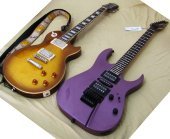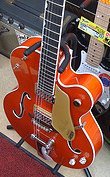Types of Electric Guitar
by Ali
(Hadian)
Hi and thanks for your great site.
I want to know how many kinds of electric guitars there are and what the differences between them are?
Thank you
Answer
Generally there are two types:
This is the main type; these guitars have no open chamber in the body. Instead, their bodies are made of solid wood, which decreases vibrations.

Ibanez GRG-270B (right)
This construction helps to avoid the feedback problem experienced with any acoustic guitar that has a built-in pickup: the sound from the speaker is picked up by the sound box of the guitar and consequently by the pickup, amplified, and returned back to the speaker; that is where it is again picked up by the guitar, and so on. This cycle continues at a very high speed, resulting in unpleasant accidental squeals.
Of course, it is still possible to achieve feedback with a solid-body guitar as well, by placing it in front of the speaker and turning the volume up loud. But we do this deliberately to get desirable squeals when we want to.
Solid-body guitars are suitable for any kind of music.

• Hollow-Body Electric Guitar
This type is kind of a hybrid of acoustic and electric guitars. Its sound box is smaller and more resistant to feedback compared to pure acoustics. The sound box contributes to the tone of the electric guitar, resulting in richer and warmer sounds compared to solid-body guitars.
This guitar can also produce sound on its own without any amplification, but surprisingly, I've never seen anyone play it without plugging into an amp.
Hollow-body guitars are better suited to blues, jazz, classical, rockabilly, and smooth rock music. High volumes and heavy distortion effects used in "hard and heavy" will make them squeal horribly.
Both these types of electric guitars have a variety of different shapes and constructions.

Photo by My Silent Side
There are three main shapes of solid-body guitars, which can be seen in the classical shapes of the Fender Stratocaster, Ibanez RG, and Les Paul Standard guitars.
Other more exotic examples of shapes include the Jackson RR3, Flying V Guitar, and Gibson Explorer.

Photo by Freebird_71
Hollow-body electric guitars are generally divided into archtop electric guitars with a full sound box and semi-hollow-body guitars.
Although it's often considered that the shape of a solid-body guitar has little, if any, impact on its tone, I can definitely say that the shape does matter. I've played a lot of electric guitars in my life and have heard differences in many cases. Of course, the type of wood used to build a guitar also has an effect on its tone.
I owned both guitars in the top picture, and while the 'Les Paul Epiphone Standard Plus' gives me a very smooth and beautiful tone on the neck pickup and a bright deep sound on the bridge pickup, the Ibanez GRG-270B has a much sharper tone, and it pushes a lot more volume from its pickups, plus it has the vibrato bar that allows me to perform crazy tricks and growls.
By the way, when I was playing around with the volume knob and the pickup switch on the Ibanez GRG-270B, I eventually managed to achieve a smoother tone for lighter guitar solos. I turned the volume knob down a bit, and it also cut down the sharpness of the sound. Next I switched to the neck + middle pickup combination, and that gave me the sound resembling the Les Paul Standard on the neck pickup, especially when I was playing above the 12th fret.
